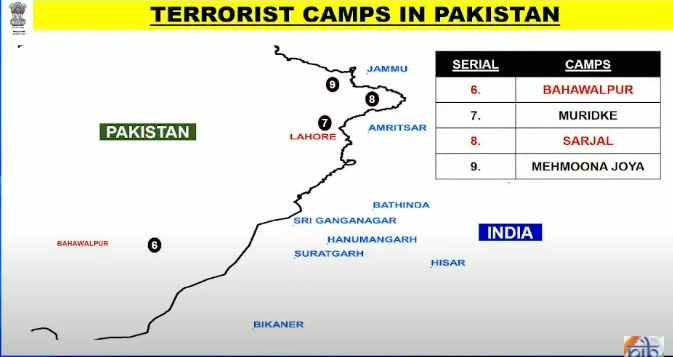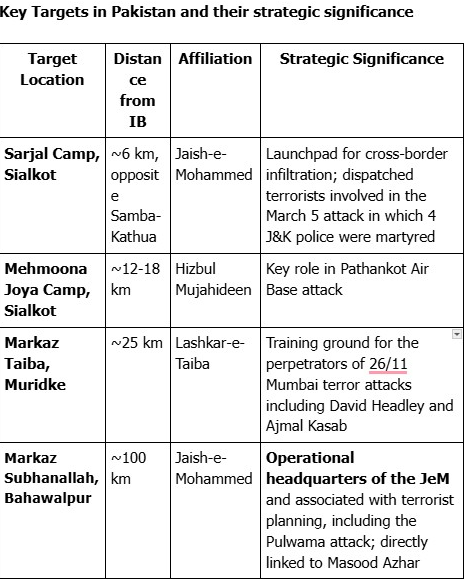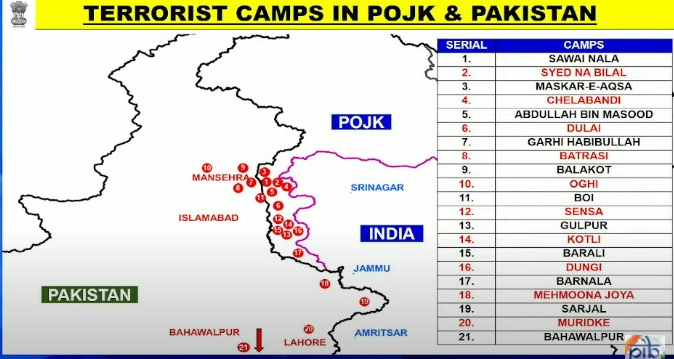Ghus Ke Mara Hain! India Goes Deep Inside Pakistan
Total Views |
In a defining moment of India’s assertive foreign policy and unyielding national security posture, the country has again demonstrated that the shackles of strategic restraint no longer bind it. With Operation Sindoor, India launched a precise and punishing surgical strike against terror infrastructure operated by Jaish-e-Mohammad, not only along the border but deep within Pakistani territory. This was not merely a response; it was a declaration. It marked the operationalisation of a bold and unapologetic security paradigm: the New India Doctrine.

Prime Minister Narendra Modi captured this spirit when he said, "Yeh Naya Bharat hai … yeh ghar mein ghusega bhi, aur marega bhi." No longer symbolic, this line has become a lived reality. It defines a fearless, proactive, and forward-leaning India that will not wait to be attacked but will strike first to neutralise threats.
The aftermath spoke volumes. The emergence of a letter by Masood Azhar, laced with panic, religious deflection, and veiled threats, is not the story’s core but a symptom of its success. It confirms what the world is now witnessing: India's counter-terror strategy has unsettled even the most hardened jihadist networks. The message is clear that terror havens across the border are no longer untouchable.
This is a new India — resurgent, resilient, and ready to dictate terms in its war against terror.
In a precise and powerful response to the recent terrorist attack in Pahalgam, India launched Operation Sindoor — a series of targeted, high-precision strikes across the international border, aimed not at civilians or infrastructure, but the very roots of cross-border terrorism. This decisive military action has sent a strong message: the new India will not hesitate to strike at the very heart of terror, even if it means crossing the border.
Under Operation Sindoor, the Indian Armed Forces conducted air strikes on nine terrorist hideouts. Four of these targets were located within Pakistan and five were in Pakistan-occupied Kashmir. Among the destroyed facilities was a key training centre established by Jaish-e-Mohammed's chief, Masood Azhar. With this strike, India demonstrated not only its military precision but also its unwavering commitment to eradicating terrorism at its roots.

Each target was chosen not only for its tactical utility but also for its symbolic weight. These were not isolated outposts, they were nerve centres of Pakistan-based terror networks, protected and supported by elements of the Pakistani establishment.
In addition to the above four primary targets, India had identified five more key locations in Pakistan on its hit list — Garhi Habibullah, Batrasi, Balakot, Oghi, and Boi. These targets were mentioned in the list of 21 training camps in the press brief held by Foreign Secretary of India, Vikram Misri along with Col. Sofiya Qureshi and Wng Cmdr Vyomika Singh.
The strategic significance highlights that India went against the roost of terror which were the training camps, launchpads, recruitment hubs, terror outfit headquarters, and logistics support.

Masood Azhar’s letter, written after the killing of his family members in an Indian airstrike, is a classic piece of jihadist propaganda — draped in religious rhetoric but soaked in cowardice and revenge. Glorifying the dead as “guests of Allah” and “flowers of Paradise,” Azhar attempts to turn personal grief into a divine mission, while he himself hides in safety. He accuses Prime Minister Narendra Modi of cowardice for targeting innocents, yet fails to acknowledge that it is his own terror factory that brought such tragedy upon his family. His words are not of a warrior, but of a man rattled by India’s bold strike across the border.
This letter is a desperate attempt to sanctify terrorism under the guise of martyrdom and an attempt to gain sympathy. By declaring that “no mercy should be expected now,” Azhar issues an open threat, signalling continued jihad. But in reality, it is a cry of defeat from a man, whose secured corridor is no longer safe. India’s doctrine of “Ghar Mein Ghus Ke Maarenge” has clearly struck fear into the heart of a man who once thought himself untouchable.
The symbolism of Operation Sindoor lies in its clarity: India will act. The idea of deterrence, once eroded by decades of cross-border proxy war, is being restored — not just with words, but with precision firepower and political will.
What separates Operation Sindoor from previous responses is its strategic clarity:
The name “Sindoor” itself — a reference to the vermilion mark of sacrifice and honour — carries both cultural depth and symbolic fire. It commemorates the innocent lives lost while warning perpetrators and their sponsors sternly.
As India continues to rise as a responsible global power, it will protect peace but will not hesitate to wield the sword when provoked. Operation Sindoor proves that India’s red lines are real — and crossing them has consequences.
India does not seek war. But if terror is exported across the border targeting India’s security personnel and civilians, the message is clear: The response will be delivered — not at the Line of Control, but in the heart of the terror camps themselves. That is the new normal. That is the new India.

Prime Minister Narendra Modi captured this spirit when he said, "Yeh Naya Bharat hai … yeh ghar mein ghusega bhi, aur marega bhi." No longer symbolic, this line has become a lived reality. It defines a fearless, proactive, and forward-leaning India that will not wait to be attacked but will strike first to neutralise threats.
The aftermath spoke volumes. The emergence of a letter by Masood Azhar, laced with panic, religious deflection, and veiled threats, is not the story’s core but a symptom of its success. It confirms what the world is now witnessing: India's counter-terror strategy has unsettled even the most hardened jihadist networks. The message is clear that terror havens across the border are no longer untouchable.
This is a new India — resurgent, resilient, and ready to dictate terms in its war against terror.
In a precise and powerful response to the recent terrorist attack in Pahalgam, India launched Operation Sindoor — a series of targeted, high-precision strikes across the international border, aimed not at civilians or infrastructure, but the very roots of cross-border terrorism. This decisive military action has sent a strong message: the new India will not hesitate to strike at the very heart of terror, even if it means crossing the border.
Under Operation Sindoor, the Indian Armed Forces conducted air strikes on nine terrorist hideouts. Four of these targets were located within Pakistan and five were in Pakistan-occupied Kashmir. Among the destroyed facilities was a key training centre established by Jaish-e-Mohammed's chief, Masood Azhar. With this strike, India demonstrated not only its military precision but also its unwavering commitment to eradicating terrorism at its roots.

Each target was chosen not only for its tactical utility but also for its symbolic weight. These were not isolated outposts, they were nerve centres of Pakistan-based terror networks, protected and supported by elements of the Pakistani establishment.
In addition to the above four primary targets, India had identified five more key locations in Pakistan on its hit list — Garhi Habibullah, Batrasi, Balakot, Oghi, and Boi. These targets were mentioned in the list of 21 training camps in the press brief held by Foreign Secretary of India, Vikram Misri along with Col. Sofiya Qureshi and Wng Cmdr Vyomika Singh.
The strategic significance highlights that India went against the roost of terror which were the training camps, launchpads, recruitment hubs, terror outfit headquarters, and logistics support.

Masood Azhar’s letter, written after the killing of his family members in an Indian airstrike, is a classic piece of jihadist propaganda — draped in religious rhetoric but soaked in cowardice and revenge. Glorifying the dead as “guests of Allah” and “flowers of Paradise,” Azhar attempts to turn personal grief into a divine mission, while he himself hides in safety. He accuses Prime Minister Narendra Modi of cowardice for targeting innocents, yet fails to acknowledge that it is his own terror factory that brought such tragedy upon his family. His words are not of a warrior, but of a man rattled by India’s bold strike across the border.
This letter is a desperate attempt to sanctify terrorism under the guise of martyrdom and an attempt to gain sympathy. By declaring that “no mercy should be expected now,” Azhar issues an open threat, signalling continued jihad. But in reality, it is a cry of defeat from a man, whose secured corridor is no longer safe. India’s doctrine of “Ghar Mein Ghus Ke Maarenge” has clearly struck fear into the heart of a man who once thought himself untouchable.
A message beyond borders
The symbolism of Operation Sindoor lies in its clarity: India will act. The idea of deterrence, once eroded by decades of cross-border proxy war, is being restored — not just with words, but with precision firepower and political will.
What separates Operation Sindoor from previous responses is its strategic clarity:
- No denial space for Pakistan: Strikes were deep enough and accurate enough to avoid civilian casualties while targeting known terror infrastructure.
- Non-escalatory by design: Avoided targeting military assets or civilian centers, thus maintaining international legitimacy.
- Message to adversaries: Any future attacks will carry a heavier price, and safe havens will not remain safe.
The blood-coloured Sindoor: A Tribute and a warning
The name “Sindoor” itself — a reference to the vermilion mark of sacrifice and honour — carries both cultural depth and symbolic fire. It commemorates the innocent lives lost while warning perpetrators and their sponsors sternly.
As India continues to rise as a responsible global power, it will protect peace but will not hesitate to wield the sword when provoked. Operation Sindoor proves that India’s red lines are real — and crossing them has consequences.
India does not seek war. But if terror is exported across the border targeting India’s security personnel and civilians, the message is clear: The response will be delivered — not at the Line of Control, but in the heart of the terror camps themselves. That is the new normal. That is the new India.

